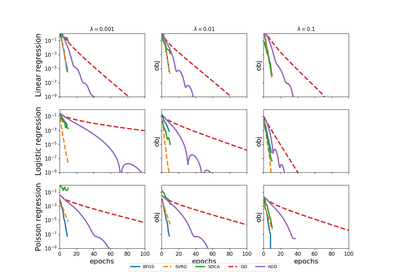tick.solver.BFGS¶
-
class
tick.solver.BFGS(tol: float = 1e-10, max_iter: int = 10, verbose: bool = True, print_every: int = 1, record_every: int = 1)[source]¶ Broyden, Fletcher, Goldfarb, and Shanno algorithm
This solver is actually a simple wrapping of
scipy.optimize.fmin_bfgsBFGS (Broyden, Fletcher, Goldfarb, and Shanno) algorithm. This is a quasi-newton algotithm that builds iteratively approximations of the inverse Hessian. This solver can be used to minimize objectives of the form\[f(w) + g(w),\]for \(f\) with a smooth gradient and only \(g\) corresponding to the zero penalization (namely
ProxZero) or ridge penalization (namelyProxL2sq). Function \(f\) corresponds to themodel.lossmethod of the model (passed withset_modelto the solver) and \(g\) corresponds to theprox.valuemethod of the prox (passed with theset_proxmethod). The iterations stop whenever tolerancetolis achieved, or aftermax_iteriterations. The obtained solution \(w\) is returned by thesolvemethod, and is also stored in thesolutionattribute of the solver.- Parameters
tol :
float, default=1e-10The tolerance of the solver (iterations stop when the stopping criterion is below it)
max_iter :
int, default=10Maximum number of iterations of the solver
verbose :
bool, default=TrueIf
True, solver verboses history, otherwise nothing is displayed, but history is recorded anywayprint_every :
int, default=10Print history information every time the iteration number is a multiple of
print_every. Used only isverboseis Truerecord_every :
int, default=1Save history information every time the iteration number is a multiple of
record_every- Attributes
model :
ModelThe model used by the solver, passed with the
set_modelmethodprox :
ProxProximal operator used by the solver, passed with the
set_proxmethodsolution :
numpy.array, shape=(n_coeffs,)Minimizer found by the solver
history :
dict-likeA dict-type of object that contains history of the solver along iterations. It should be accessed using the
get_historymethodtime_start :
strStart date of the call to
solve()time_elapsed :
floatDuration of the call to
solve(), in secondstime_end :
strEnd date of the call to
solve()dtype :
{'float64', 'float32'}, default=’float64’Type of the arrays used. This value is set from model and prox dtypes.
References
Quasi-Newton method of Broyden, Fletcher, Goldfarb and Shanno (BFGS), see Wright, and Nocedal ‘Numerical Optimization’, 1999, pg. 198.
-
__init__(tol: float = 1e-10, max_iter: int = 10, verbose: bool = True, print_every: int = 1, record_every: int = 1)[source]¶ Initialize self. See help(type(self)) for accurate signature.
-
get_history(key=None)¶ Returns history of the solver
- Parameters
key :
str, default=NoneIf
Noneall history is returned as adictIf
str, name of the history element to retrieve
- Returns
output :
listordictIf
keyis None orkeyis not in history then output is a dict containing history of all keysIf
keyis the name of an element in the history, output is alistcontaining the history of this element
-
objective(coeffs, loss: float = None)¶ Compute the objective function
- Parameters
coeffs :
np.array, shape=(n_coeffs,)Point where the objective is computed
loss :
float, default=`None`Gives the value of the loss if already known (allows to avoid its computation in some cases)
- Returns
output :
floatValue of the objective at given
coeffs
-
set_model(model: tick.base_model.model.Model)[source]¶ Set model in the solver
- Parameters
model :
ModelSets the model in the solver. The model gives the first order information about the model (loss, gradient, among other things)
- Returns
output :
SolverThe
Solverwith given model
-
set_prox(prox: tick.prox.base.prox.Prox)[source]¶ Set proximal operator in the solver.
- Parameters
prox :
ProxThe proximal operator of the penalization function
- Returns
output :
SolverThe solver with given prox
Notes
In some solvers,
set_modelmust be called beforeset_prox, otherwise and error might be raised.
